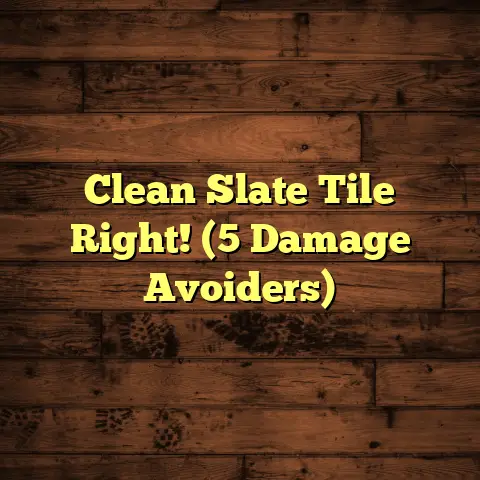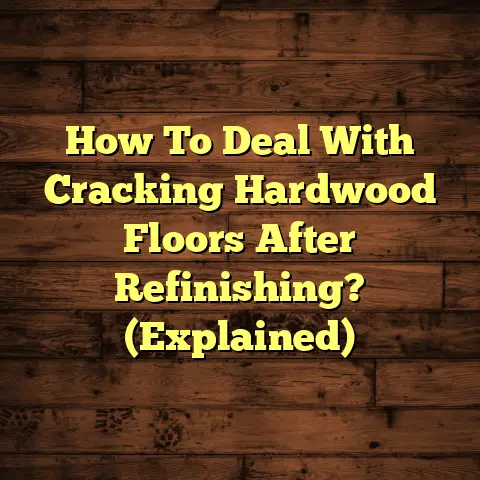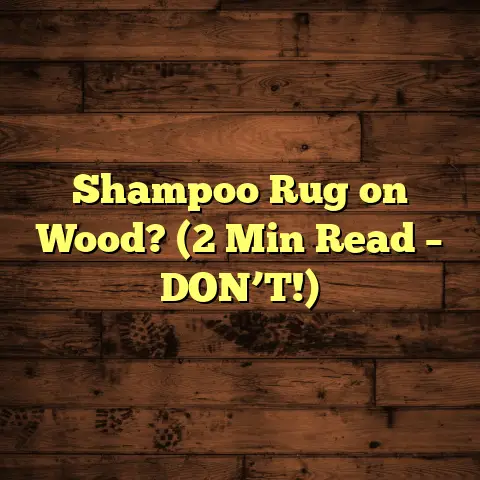Lifeproof Needs Moisture Barrier? (2 Barrier Facts!)
In a world where waterproofing technology boasts unparalleled advancements, the question of whether a flooring product marketed as ‘lifeproof’ truly requires a moisture barrier seems almost counterintuitive.
How can something designed to withstand spills and stains still be vulnerable to the silent, creeping threat of moisture from below?
Lifeproof Needs Moisture Barrier?
I’ve seen it all, from glorious installations to heartbreaking failures, and more often than not, moisture is the culprit behind those flooring disasters.
Today, let’s tackle a question I get asked all the time: Does Lifeproof flooring really need a moisture barrier?
It’s a hot topic, especially since Lifeproof has become so popular.
We’ll dive into the nitty-gritty, separating fact from fiction.
What We’ll Cover:
- Understanding Lifeproof Flooring: What it is, what it isn’t, and why everyone’s talking about it.
- The Role of Moisture Barriers: Your floor’s unsung hero.
- Fact #1 – Moisture Sources and Risks: Where moisture comes from and what it can do to your floors.
- Fact #2 – Compatibility of Lifeproof with Moisture Barriers: When you absolutely need one, and when you might get away without.
- Installation Considerations: Tips and tricks from a seasoned pro.
- Maintenance and Long-Term Care: Keeping your Lifeproof floor looking its best for years to come.
- Conclusion: Tying it all together.
So, grab a cup of coffee (or maybe something stronger, depending on your last flooring project!), and let’s get started.
Section 1: Understanding Lifeproof Flooring
Okay, first things first: what exactly is Lifeproof flooring?
Lifeproof is a brand of flooring primarily sold at Home Depot, known for its waterproof qualities and durability.
It’s usually a type of luxury vinyl plank (LVP) or luxury vinyl tile (LVT).
Think of it as the superhero of flooring, promising to withstand just about anything life throws at it.
Key Features:
- Waterproof Core: This is the heart of Lifeproof.
The core is typically made of a waterproof material, preventing water from penetrating the plank. - Wear Layer: A tough, transparent layer that protects the decorative surface from scratches, dents, and wear.
- Attached Underlayment: Many Lifeproof products come with a pre-attached underlayment, which can save you time and money during installation.
- Realistic Appearance: Lifeproof flooring mimics the look of hardwood, tile, or stone, offering a stylish alternative at a lower cost.
Selling Points:
- Durability: Designed to withstand heavy foot traffic, pets, and kids.
- Ease of Maintenance: Simple to clean and maintain, requiring only regular sweeping and mopping.
- Water Resistance: Ideal for kitchens, bathrooms, and basements where moisture is a concern.
- DIY-Friendly Installation: Many Lifeproof products feature a click-lock system, making them easy to install yourself.
Who’s Buying Lifeproof?
I’ve seen Lifeproof installed in a wide range of environments:
- Residential Homes: From single-family homes to apartments and condos.
- Commercial Spaces: Light commercial settings like offices, retail stores, and restaurants.
- Rental Properties: Landlords love Lifeproof for its durability and low maintenance.
- High-Traffic Areas: Entryways, hallways, and living rooms.
Basically, anyone who wants a durable, waterproof, and stylish floor at a reasonable price is a potential Lifeproof customer.
Section 2: The Role of Moisture Barriers
Now, let’s talk about moisture barriers.
Think of them as your floor’s personal bodyguard, protecting it from the unseen enemy: moisture.
What is a Moisture Barrier?
A moisture barrier is a material designed to prevent moisture from migrating from the subfloor (the surface beneath your flooring) into the flooring itself.
It’s typically a thin sheet of plastic or a specialized membrane.
Types of Moisture Barriers:
- Polyethylene Film (Poly Film): This is the most common type of moisture barrier.
It’s inexpensive and easy to install.
Usually comes in 6-mil thickness. - Vapor Retarders: These are designed to slow down the movement of moisture vapor, rather than completely block it.
- Liquid-Applied Membranes: These are applied directly to the subfloor and create a seamless, waterproof barrier.
- Specialized Underlayments: Some underlayments have a built-in moisture barrier.
How Moisture Penetrates Flooring:
Moisture can sneak into your flooring in a variety of ways:
- Ground Moisture: Moisture from the soil beneath your foundation can seep up through the concrete slab.
- Humidity: High humidity levels can cause moisture to condense on the subfloor.
- Spills and Leaks: Accidents happen!
Spills and leaks can penetrate the flooring if not cleaned up quickly. - Improper Ventilation: Poor ventilation can trap moisture in the subfloor.
The Potential Damage:
Ignoring moisture can lead to a whole host of problems:
- Mold and Mildew Growth: Moisture creates the perfect breeding ground for mold and mildew, which can cause health problems and unpleasant odors.
- Warping and Buckling: Moisture can cause the flooring to warp, buckle, and become uneven.
- Adhesive Failure: Moisture can weaken the adhesive that holds the flooring in place, causing it to loosen and separate.
- Reduced Lifespan: Ultimately, moisture damage can significantly reduce the lifespan of your flooring.
Section 3: Fact #1 – Moisture Sources and Risks
Let’s dig deeper into where this sneaky moisture comes from and what it can do to your beloved floors.
Common Moisture Sources:
- Groundwater: This is a big one, especially in basements or homes with slab foundations.
Groundwater can wick up through the concrete, bringing moisture along for the ride. - Rain and Snow: Water can seep into your home through cracks in the foundation, leaky roofs, or poorly sealed windows and doors.
- Plumbing Leaks: A leaky pipe, a dripping faucet, or a running toilet can introduce significant amounts of moisture into your home.
- Humidity: High humidity levels, especially in warmer months, can lead to moisture condensation on cool surfaces like your subfloor.
- Spills: Obvious, right? But even small, unnoticed spills can cause problems over time.
The Risks of Ignoring Moisture Barriers:
- Mold Infestation: I’ve seen firsthand the havoc mold can wreak.
It’s not just unsightly; it’s a health hazard.
Mold spores can trigger allergies, asthma, and other respiratory problems. - Structural Damage: Moisture can weaken the subfloor, leading to rot and decay.
In severe cases, this can compromise the structural integrity of your home. - Flooring Failure: As I mentioned earlier, moisture can cause warping, buckling, and adhesive failure.
This means you’ll be replacing your floors sooner than you’d like. - Unpleasant Odors: Mold and mildew produce musty, unpleasant odors that can permeate your entire home.
- Reduced Indoor Air Quality: Mold spores and other contaminants released by moisture damage can negatively impact your indoor air quality.
Real-World Examples:
I remember one job where a homeowner had installed Lifeproof flooring in their basement without a moisture barrier.
They thought they were safe because Lifeproof is waterproof.
Within a year, they started noticing a musty smell and the flooring began to buckle.
When I pulled up the flooring, I found a thriving mold colony underneath.
The homeowner had to spend thousands of dollars on mold remediation and new flooring.
Another case involved a commercial space where a plumbing leak went unnoticed for weeks.
The moisture seeped under the Lifeproof flooring, causing the adhesive to fail and the planks to lift.
The business had to close for several days while the flooring was repaired.
These are just a couple of examples of what can happen when you ignore the risks of moisture.
Section 4: Fact #2 – Compatibility of Lifeproof with Moisture Barriers
This is where things get interesting.
Lifeproof is waterproof, so does it really need a moisture barrier?
The answer, as with most things in flooring, is: it depends.
How Lifeproof Interacts with Moisture Barriers:
Lifeproof flooring itself is waterproof, meaning it won’t absorb water from the top down.
However, it doesn’t prevent moisture from rising up from the subfloor.
That’s where a moisture barrier comes in.
When a Moisture Barrier is Necessary:
- Concrete Subfloors: Concrete is porous and can wick up moisture from the ground.
If you’re installing Lifeproof over a concrete slab, a moisture barrier is almost always recommended. - Below-Grade Installations: Basements are particularly prone to moisture problems.
A moisture barrier is essential in these environments. - High-Moisture Environments: If you live in a humid climate or have a history of moisture problems in your home, a moisture barrier is a good idea.
- Manufacturer Recommendations: Always check the manufacturer’s instructions for your specific Lifeproof product.
Some manufacturers may require a moisture barrier in certain situations.
According to Home Depot’s website, most Lifeproof flooring installations over concrete require a 6-mil polyethylene film moisture barrier.
Potential Exceptions:
- Above-Grade Installations: If you’re installing Lifeproof on an upper floor of your home, and you don’t have any known moisture problems, you might be able to get away without a moisture barrier.
However, I still recommend checking with the manufacturer. - Existing Moisture Barrier: If your subfloor already has a built-in moisture barrier, you may not need to add another one.
Important Considerations:
- Subfloor Moisture Testing: Before installing any flooring, it’s crucial to test the moisture level of your subfloor.
A moisture meter can help you determine if a moisture barrier is necessary. - Local Building Codes: Some local building codes may require a moisture barrier, regardless of the flooring type.
- Warranty Requirements: Failing to follow the manufacturer’s instructions regarding moisture barriers could void your warranty.
Section 5: Installation Considerations
Alright, let’s get down to the nitty-gritty of installation.
Whether you’re a seasoned DIYer or a first-time installer, these tips will help you get the job done right.
Best Practices for Installing Lifeproof with a Moisture Barrier:
- Subfloor Preparation: This is the most important step.
Make sure your subfloor is clean, level, and dry.
Remove any debris, nails, or screws.
Fill any cracks or holes with a patching compound. - Moisture Testing: Use a moisture meter to test the moisture level of your subfloor.
If it’s above the recommended level (usually around 3-5%), you’ll need to address the moisture problem before installing the flooring. - Moisture Barrier Installation: Roll out the moisture barrier over the subfloor, overlapping the seams by at least 6 inches.
Tape the seams with moisture-resistant tape. - Underlayment (Optional): If your Lifeproof flooring doesn’t have a pre-attached underlayment, you may want to install a separate underlayment for added comfort and sound insulation.
- Flooring Installation: Follow the manufacturer’s instructions for installing the Lifeproof flooring.
Use spacers to maintain consistent expansion gaps around the perimeter of the room. - Finishing Touches: Install baseboards and trim to cover the expansion gaps and give your floor a finished look.
Installing Lifeproof Without a Moisture Barrier:
If you’ve determined that a moisture barrier isn’t necessary, you can skip steps 2 and 3 above.
However, you should still:
- Subfloor Preparation: Ensure your subfloor is clean, level, and dry.
- Underlayment (Optional): Consider installing an underlayment for added comfort and sound insulation.
- Flooring Installation: Follow the manufacturer’s instructions for installing the Lifeproof flooring.
- Finishing Touches: Install baseboards and trim.
Common Installation Mistakes:
- Skipping Subfloor Preparation: This is a recipe for disaster.
A poorly prepared subfloor can lead to uneven flooring, squeaks, and other problems. - Ignoring Moisture Levels: Installing flooring over a damp subfloor is a surefire way to invite mold and mildew.
- Improper Moisture Barrier Installation: Failing to overlap the seams or tape them properly can render the moisture barrier ineffective.
- Tight Fit: Not leaving enough expansion gaps around the perimeter of the room can cause the flooring to buckle as it expands and contracts with temperature and humidity changes.
Section 6: Maintenance and Long-Term Care
You’ve installed your Lifeproof flooring, and it looks fantastic!
Now, how do you keep it looking that way for years to come?
Regular Maintenance:
- Sweep or Vacuum Regularly: This will remove dirt, dust, and debris that can scratch the surface of the flooring.
- Mop with a Damp Mop: Use a mild detergent and a damp mop to clean the flooring.
Avoid using excessive water, as this can seep into the seams. - Clean Up Spills Immediately: Wipe up spills as soon as they occur to prevent staining.
- Use Floor Protectors: Place felt pads under furniture legs to prevent scratches and dents.
- Avoid Harsh Chemicals: Don’t use abrasive cleaners, bleach, or ammonia on your Lifeproof flooring.
Inspections and Signs of Moisture Damage:
- Check for Musty Odors: A musty smell can be a sign of mold or mildew growth.
- Look for Warping or Buckling: These are signs that the flooring has been exposed to moisture.
- Inspect the Seams: Check the seams for gaps or cracks, which can allow moisture to penetrate.
- Feel for Dampness: If you feel dampness on the surface of the flooring, it could indicate a moisture problem.
Managing Humidity and Moisture Levels:
- Use a Dehumidifier: In humid climates, a dehumidifier can help to reduce moisture levels in your home.
- Improve Ventilation: Ensure that your home is properly ventilated, especially in bathrooms and kitchens.
- Fix Leaks Promptly: Repair any plumbing leaks as soon as possible.
- Seal Cracks in the Foundation: Seal any cracks in your foundation to prevent moisture from seeping into your home.
Section 7: Conclusion
So, there you have it!
We’ve covered everything you need to know about Lifeproof flooring and moisture barriers.
To recap:
- Lifeproof flooring is waterproof, but it doesn’t prevent moisture from rising up from the subfloor.
- A moisture barrier is often necessary, especially over concrete subfloors, in basements, and in high-moisture environments.
- Always check the manufacturer’s instructions and local building codes.
- Proper subfloor preparation and installation are crucial.
- Regular maintenance and inspections can help to prevent moisture damage.
Ultimately, the decision of whether or not to use a moisture barrier with Lifeproof flooring depends on your specific circumstances.
Consider your subfloor type, your climate, and your risk tolerance.
Don’t be afraid to consult with a flooring professional if you’re unsure.
In the end, choosing the right flooring is about more than just aesthetics.
It’s about understanding the environment and protecting your investment for years to come.
Think of your flooring as a long-term relationship: it requires understanding, care, and a little bit of protection to truly thrive.





